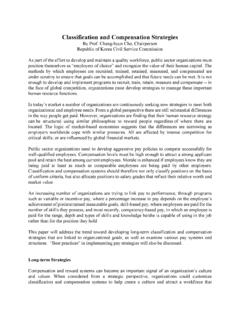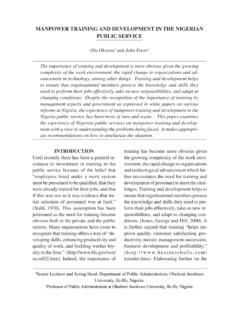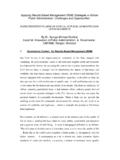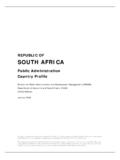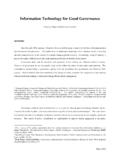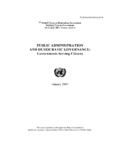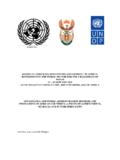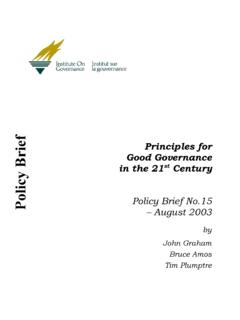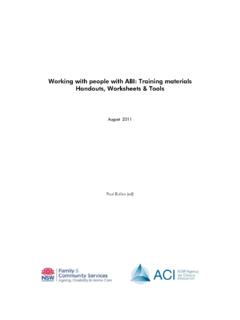Transcription of Human Capital Development in Singapore: An - United …
1 Articles Human Capital Development Advances in Developing Osman-Gani / HRD IN singapore . Human Resources August 2004. in singapore : An Analysis of National Policy Perspectives AAhad M. Osman-Gani Nanyang Technological University, singapore The problem and the solution. singapore provides an inter- esting case study of Human Capital Development (HCD) as national strategy. Its Human resource strategies have been con- tinuously revised and adjusted in conjunction with other national strategic economic policies. Although some studies have been done on microlevel Human resource Development (HRD) practices, very little research has been done on the stra- tegic and macrolevel policy perspectives. This article presents an analysis of macrolevel HCD strategies in singapore from a national policy perspective and describes the elements of the HRD infrastructure.
2 Keywords: singapore ; national policy; Human Capital Development Human resources have been identified as the single most important strategic Capital for singapore . A small country with virtually no natural resources, singapore has become one of the most developed countries in Asia primar- ily due to its strong emphasis on developing Human resources and for con- tinuously making significant investments in its Human Capital . Human resource Development (HRD) has always been a core element in its strategic economic plans, as reflected in the eight strategic thrusts of its Strategic Economic Plan (Ministry of Trade and Industry, 1993; C. Tan, 1996; Wong & Ng, 1993). The outcome of these initiatives could be found in the reports of the organization Business Environment Risk Intelligence (BERI), which has ranked singapore 's workers as the best in the world for relative productivity (Standards, Productivity and Innovation Board, 2003).
3 Also, the World Competitiveness Yearbook of the International Institute for Management Development (IMD) placed singapore 's workforce competi- Note: This article was subject to a 2-tier review that did not involve authors who are members of the ADHR Editorial Board. Advances in Developing Human Resources Vol. 6, No. 3 August 2004 276-287. DOI: Copyright 2004 Sage Publications Osman-Gani / HRD IN singapore 277. tiveness at par with that of the United States and other developed countries (Ministry of Manpower, 2003a). In the early days of its economic develop- ment, the efforts at HRD came under the rubric of manpower Development , general education, technical education, and training. As it moved from investment-driven economic growth to that which is driven by innovation, together with its emphasis on the regionalization and globalization of busi- ness, the government has embarked on more sophisticated HRD strategies.
4 The HRD strategies have been continuously revised and adjusted in con- junction with other national strategic economic policies. singapore is thus a unique case that exemplifies the benefits of national HRD policies and strat- egies. Although there have been some studies done on microlevel HRD. practices, very little research has been done in this respect on the strategic and macrolevel policy perspectives (Osman-Gani, 1996; Osman-Gani &. Tan, 1998, 2000; Osman-Gani & Toh, 1997). This article presents an analy- sis of the macrolevel Human Capital Development (HCD) strategies in Singa- pore from a national policy perspective and describes the elements of the HRD infrastructure. The objective is to present a descriptive account of various aspects of the Human resource strategies adopted in singapore in the course of its economic Development .
5 Several terminologies have been used in the past that emphasized the importance of HRD based on the changing perspectives of national policy dimensions of singapore : Human resource Development , manpower devel- opment, people Development , training and skills Development , workforce Development , and Human Capital Development . Increasingly, emphasis has been on HCD, which considers people the significant strategic Capital on whom investments should be made to derive the desired returns in terms of improved performance. In this article, HCD and HRD are used interchangeably. National Policy and HCD Infrastructure In singapore , the policy infrastructure for HCD is characterized by two distinct features: a tripartite approach, based on cooperation among employers, unions, and government; and a multidepartmental approach involving all relevant government agencies.
6 The following sections provide more details in this regard. The Tripartite System The tripartite relationship ensures that there is agreement over strategies and necessary steps required for national HRD strategies. The policy of worker training and retraining to upgrade them with skills for the economic restructuring in the early 1980s was possible only with the acceptance and cooperation of the unions. An example is the Manpower 21 Report, 278 Advances in Developing Human Resources August 2004. launched on June 4, 1998, which was produced by a partnership among the government ministry, unions, and more than 100 participants from the pri- vate sector (Ministry of Manpower, 2003a). Another important tripartite institution is the Skills Development Fund (SDF), founded by the government and guided by a tripartite council.
7 The fund is both a mechanism for financing the employee training and a motiva- tion to employers to upgrade their employees. The SDF was created because employers in singapore are not normally inclined to spend money on train- ing unless there is a scheme to entice them to do so. All employers contribute 1% of the total wages of employees who earn S$1,500 or less (revised from S$1,000) a month or $2 per employee (whichever is greater) a month to the SDF. Employers can use this fund by claiming about 90% of the training subsidy for their employees' skills Development through the SDF. Thus, employers are motivated to send their employees for these training pro- grams, because that is the only avenue through which they can derive benefit from their contributions (Ministry of Manpower, 2003a; Skills Develop- ment Fund, 2003).
8 In 2000, the Skills Development Levy was revised to provide more funds for skills upgrading. The Skills Re- Development Programme (SRP), which started with the manufacturing sector, was extended to support worker train- ing in service sectors. Also, an S$5 billion Lifelong Learning Fund was established, and a School of Lifelong Learning will be set up to provide con- tinuous skills Development . In addition, the government helped raise funds and gave a matching grant to the NTUC's (National Trade Union Congress). Education and Training Fund (N-ETF). A DomestiCaRE program was also launched, aimed at helping retrenched and unemployed Singaporeans reskill to fill job vacancies in the domestic housekeeping industry over the next year (Ministry of Manpower, 2003a). The National Wages Council (NWC) plays an important role in HCD.
9 Because it is responsible for motivational aspects of performance in terms of compensation and other elements of the wage package. As a tripartite body, it conducts an annual audit of changes in the singapore economy, particu- larly in the wages sector in relation to the level of employment and unem- ployment, international competitiveness, equity to workers and employers, inflation rate, and productivity enhancement (Lim, 1994). The audit pro- vides the council with information to set out wage guidelines that form the basis of reference should employers and unions fail to agree on wage issues (Tan, 1998). The recommendations for wage adjustments made by the NWC. have highlighted the significance of training and retraining for improving productivity, increasing economic Development , and meeting the chal- lenges of global competition (Ministry of Manpower, 2003b; Osman-Gani & Tan, 2000).
10 Osman-Gani / HRD IN singapore 279. The Multidepartmental Approach As for the second factor, singapore uses a multidepartmental approach to its national policies for HCD. Prior to 1998, the Ministry of Trade and Industry and its various agencies, such as the Investment Board, ascertained information about future Human resource needs (Ministry of Trade and Industry, 1998). The information is collated by the Ministry and translated by the Economic Development Board (EDB) into targets for the specific skills required by the nation, then forwarded to the Council for Pro- fessional and Technical Education (CPTE) for its deliberation. The relevant agencies then provided feedback on the timeframes within which they would be able to attain those targets. The council, formed in 1979, deter- mined the specific numbers of different skills to be developed by the univer- sities, polytechnics, schools, and Institutes of Technical Education (ITE).
